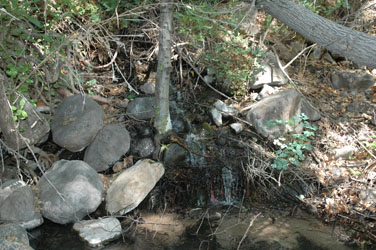Aquifer Characteristics
The regional aquifer in the Mogollon Rim area mainly comprises the Coconino, Supai, and Naco Formations, but perched aquifers are common throughout in units like the Kaibab Formation and the Tertiary Volcanics. The Naco formation does not crop out in the Beaver Creek area, so it is likely not present. Thus, in the Beaver Creek watershed, the main water-bearing and water-transmitting units are the Coconino, Supai, Kaibab, and the Tertiary Volcanics.

A spring discharging into Wet Beaver Creek on 20 Jun 2006. The source of the spring is obscured, but it is likely Coconino Sandstone
Aquifer Dynamics
Not much has been written about groundwater in the Beaver Creek area. What has been written about the hydrology of the watershed largely omits any discussion of groundwater. Baker (1982) notes that 98% of precipitation that falls within the watershed is lost to evapotranspiration and surface flow, so groundwater recharge within the watershed is negligible. Nevertheless, groundwater discharging from springs contributes to surface flow, so groundwater does play an important role in the watershed.
It is important to note that this spring discharge is likely coming from groundwater that is recharged on the Colorado Plateau, meaning that the surface water in the Beaver Creek watershed is hydraulically connected to the groundwater and, ultimately, the surface water on the plateau. The spring shown above was discharging at a low to moderate flow rate in June 2006, following an unusually dry winter and spring, suggesting that the rate of transmission of water through the aquifer is slow. Thus, the practice of treating groundwater and surface water as separate entities in water management strategies is a dangerous endeavor, especially in semi-arid watersheds.
Owen-Joyce and Bell (1983) note that springs in the Coconino Sandstone maintain the perennial flow in Wet Beaver Creek, with variable discharge rates ranging from 75 to more than 1,000 gal/min. These flow rates, however, are highly variable from one spring to the next and are dependent upon weather, season, human impacts, and other factors. For example, the spring shown above was only discharging at about 2-3 gal/min. The importance of discharge variability was highlighted by Flora (2003) in a study of springs in the Middle Verde Watershed.
|




